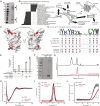Engineered SARS-CoV-2 receptor binding domain improves manufacturability in yeast and immunogenicity in mice
- PMID: 34493582
- PMCID: PMC8463846
- DOI: 10.1073/pnas.2106845118
Engineered SARS-CoV-2 receptor binding domain improves manufacturability in yeast and immunogenicity in mice
Abstract
Global containment of COVID-19 still requires accessible and affordable vaccines for low- and middle-income countries (LMICs). Recently approved vaccines provide needed interventions, albeit at prices that may limit their global access. Subunit vaccines based on recombinant proteins are suited for large-volume microbial manufacturing to yield billions of doses annually, minimizing their manufacturing cost. These types of vaccines are well-established, proven interventions with multiple safe and efficacious commercial examples. Many vaccine candidates of this type for SARS-CoV-2 rely on sequences containing the receptor-binding domain (RBD), which mediates viral entry to cells via ACE2. Here we report an engineered sequence variant of RBD that exhibits high-yield manufacturability, high-affinity binding to ACE2, and enhanced immunogenicity after a single dose in mice compared to the Wuhan-Hu-1 variant used in current vaccines. Antibodies raised against the engineered protein exhibited heterotypic binding to the RBD from two recently reported SARS-CoV-2 variants of concern (501Y.V1/V2). Presentation of the engineered RBD on a designed virus-like particle (VLP) also reduced weight loss in hamsters upon viral challenge.
Keywords: Pichia pastoris; SARS-CoV-2; manufacturability; protein vaccine.
Copyright © 2021 the Author(s). Published by PNAS.
Conflict of interest statement
Competing interest statement: L.E.C., K.R.L., and J.C.L. have filed patents related to the InSCyT system and methods. N.C.D., S.R.A., and J.C.L. have filed a patent related to the RBD-L452K-F490W sequence. K.R.L., L.E.C., and M.K.T. are current employees at Sunflower Therapeutics PBC. N.P.K., J.Y.W., and C.W. are named as inventors on patent applications filed by the University of Washington related to the I3-01 nanoparticle. N.P.K. is a co-founder, shareholder, paid consultant, and chair of the scientific advisory board of Icosavax, Inc. and has received an unrelated sponsored research agreement from Pfizer. J.C.L. has interests in Sunflower Therapeutics PBC, Pfizer, Honeycomb Biotechnologies, OneCyte Biotechnologies, QuantumCyte, Amgen, and Repligen. J.C.L.’s interests are reviewed and managed under MIT’s policies for potential conflicts of interest. J.M.S. is an employee of the Bill & Melinda Gates Medical Research Institute. H.K. is an employee of the Bill & Melinda Gates Foundation.
Figures



Update of
-
Engineered SARS-CoV-2 receptor binding domain improves immunogenicity in mice and elicits protective immunity in hamsters.bioRxiv [Preprint]. 2021 Mar 4:2021.03.03.433558. doi: 10.1101/2021.03.03.433558. bioRxiv. 2021. Update in: Proc Natl Acad Sci U S A. 2021 Sep 21;118(38):e2106845118. doi: 10.1073/pnas.2106845118. PMID: 33688647 Free PMC article. Updated. Preprint.
Similar articles
-
Engineered SARS-CoV-2 receptor binding domain improves immunogenicity in mice and elicits protective immunity in hamsters.bioRxiv [Preprint]. 2021 Mar 4:2021.03.03.433558. doi: 10.1101/2021.03.03.433558. bioRxiv. 2021. Update in: Proc Natl Acad Sci U S A. 2021 Sep 21;118(38):e2106845118. doi: 10.1073/pnas.2106845118. PMID: 33688647 Free PMC article. Updated. Preprint.
-
Molecular engineering of a cryptic epitope in Spike RBD improves manufacturability and neutralizing breadth against SARS-CoV-2 variants.Vaccine. 2023 Jan 27;41(5):1108-1118. doi: 10.1016/j.vaccine.2022.12.062. Epub 2022 Dec 29. Vaccine. 2023. PMID: 36610932 Free PMC article.
-
An Engineered Receptor-Binding Domain Improves the Immunogenicity of Multivalent SARS-CoV-2 Vaccines.mBio. 2021 May 11;12(3):e00930-21. doi: 10.1128/mBio.00930-21. mBio. 2021. PMID: 33975938 Free PMC article.
-
Will Mutations in the Spike Protein of SARS-CoV-2 Lead to the Failure of COVID-19 Vaccines?J Korean Med Sci. 2021 May 10;36(18):e124. doi: 10.3346/jkms.2021.36.e124. J Korean Med Sci. 2021. PMID: 33975397 Free PMC article. Review.
-
Severe acute respiratory syndrome-coronavirus-2 spike (S) protein based vaccine candidates: State of the art and future prospects.Rev Med Virol. 2021 May;31(3):e2183. doi: 10.1002/rmv.2183. Epub 2020 Oct 15. Rev Med Virol. 2021. PMID: 33594794 Free PMC article. Review.
Cited by
-
Advances in SARS-CoV-2 receptor-binding domain-based COVID-19 vaccines.Expert Rev Vaccines. 2023 Jan-Dec;22(1):422-439. doi: 10.1080/14760584.2023.2211153. Expert Rev Vaccines. 2023. PMID: 37161869 Free PMC article. Review.
-
Accelerating cell culture media development using Bayesian optimization-based iterative experimental design.Nat Commun. 2025 Jul 1;16(1):6055. doi: 10.1038/s41467-025-61113-5. Nat Commun. 2025. PMID: 40593792 Free PMC article.
-
Vaccine hesitancy towards COVID vaccine among unvaccinated frontline health care workers working in a designated COVID care center: A cross-sectional study.J Family Med Prim Care. 2022 Sep;11(9):5077-5081. doi: 10.4103/jfmpc.jfmpc_1314_21. Epub 2022 Oct 14. J Family Med Prim Care. 2022. PMID: 36505612 Free PMC article.
-
OVX033, a nucleocapsid-based vaccine candidate, provides broad-spectrum protection against SARS-CoV-2 variants in a hamster challenge model.Front Immunol. 2023 Jun 19;14:1188605. doi: 10.3389/fimmu.2023.1188605. eCollection 2023. Front Immunol. 2023. PMID: 37409116 Free PMC article.
-
Improved Expression of SARS-CoV-2 Spike RBD Using the Insect Cell-Baculovirus System.Viruses. 2022 Dec 15;14(12):2794. doi: 10.3390/v14122794. Viruses. 2022. PMID: 36560798 Free PMC article.
References
-
- Gates B., Responding to Covid-19 - A once-in-a-century pandemic? N. Engl. J. Med. 382, 1677–1679 (2020). - PubMed
-
- Teerawattananon Y., Dabak S. V., COVID vaccination logistics: Five steps to take now. Nature 587, 194–196 (2020). - PubMed
-
- Shekhar C., Pichia power: India’s biotech industry puts unconventional yeast to work. Chem. Biol. 15, 201–202 (2008). - PubMed
Publication types
MeSH terms
Substances
Supplementary concepts
Grants and funding
LinkOut - more resources
Full Text Sources
Other Literature Sources
Medical
Molecular Biology Databases
Miscellaneous

